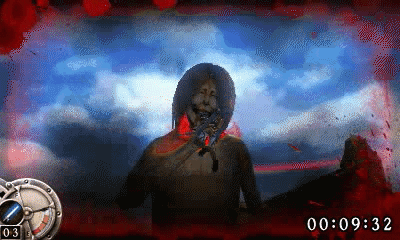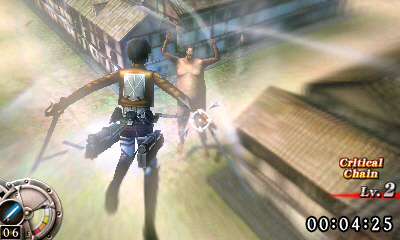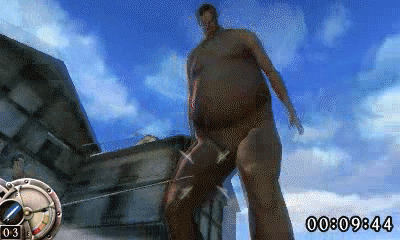We love playing David to countless video game Goliaths. Bosses are, more often than not, larger than the game heroes who defeat them. In Attack on Titan: Humanity in Chains, you're never short of giants to vanquish as you reenact scenes from the anime and manga from which the game was adapted. If there are thrills to be found, they come from swinging through a map using the maneuver gear. Using this mobility against the titans can provide a rush as you amass your first dozen kills, but don't expect this excitement to last. Humanity in Chains is a surprisingly soulless affair, a reminder that sometimes it takes a game packed with titans to make us appreciate refined adventures with fewer behemoths.
Much of the best anime is set in worlds you wish you could visit, such as the early 1980s interpretation of metropolitan Japan in Urusei Yatsura, or the sprawling vision of Earth in Dragon Ball. As good as the original material is, its setting is an utterly miserable world. One hundred years of peace have just been shattered by the return of remorseless giants who only want to eat humans. What are you to do but try to defend yourself, especially if you're a revenge-hungry teen who watched helplessly as your mom became a snack? The titans' perpetually maniacal faces only add insult to one's presumable fate to become a decapitated morsel. For once, we have an anime in which teenage whining, scolding, and anxiety-driven introspection is justified, even if all this motivational talk, pointless or otherwise, comprises one-third of the anime's content.

Humanity in Chains spares you these moments of angst while framing story missions with many of the show's most memorable scenes. If this game is partly designed to attract Attack on Titan virgins to watch the show, these brief videos are its most effective selling tools. The game is punctuated by the two opening themes and credits. If anything convinces you that you're about to experience the playable version of a well-received anime, it is the rehashing of a catchy and memorable title sequence. I haven't watched Attack on Titan since it appeared on Netflix over a year ago, so reacquainting myself with the resoundingly Germanic choral chanting was exciting, if only for a few minutes. The only thing missing is a Netflix streaming voucher to watch the show on the 3DS.
Attack on Titan inadvertently poses a question that could have been asked decades ago: What if Spider-Man had a penchant for bladed melee weapons and his arms were freed from web-slinging? Add the mutant-hunting sentinels and you essentially have the gameplay premise for Humanity in Chains. Much like Spider-Man, you don't question how your gear manages to find an attachment point every time; you just run with it because there are more pressing matters, like a city filled with invading titans. You spend most of your time swinging from point to point because moving on foot is impractical and, more importantly, is the easiest way to get yourself killed.

The point of all this maneuverability is to position yourself to attack the titans' napes, their main weak spot. Thanks to a lock-on function, this is a peculiarly simple task, provided you make an effort to avoid approaching titans from the front. Once you've initiated the attack, the only challenge lies in lining up a timing ring within a larger ring; pulling that off results in a hit. This challenge, unfortunately, makes up the bulk of your goals in Humanity in Chains, so it's normal to feel bored after about an hour of play. Aside from an optional spin attack and the ability to hinder a titan's mobility, there's no depth or nuance to combat. You're either aiming to deal a lethal blow to the titan or you're making a brief retreat in order to regroup. We've come to expect third-person adventures chocked full of objectives in a given sortie, which can take anywhere from 15 to 90 minutes to complete. There are missions in Humanity in Chains that take 30 seconds to clear. And when you're not killing titans, your tasks are more menial jobs, like performing CPR on fallen comrades or collecting food. The art department didn't even design the food; you just have to find gleaming blue dots on the ground.
Not wanting to stick solely to the anime's script, developer Spike Chunsoft added world mode, a feature that lets you grow and customize your own squad of titan killers and team up in multiplayer. It's a well-intentioned mode that is meant to add replay value and an RPG-inspired sense of character ownership by starting you off with baseline stats. The world mode menu screen overlooks a base with multiple facilities, giving you the impression that there are a lot of activities there with which to eat up an afternoon. It is true that you can upgrade squadmates' abilities and craft weapons in world mode, but incentives to apply these enhancements in the field are sorely lacking. Not only are you stuck with the same types of titan takedown missions found in story mode, but now you're greatly underpowered. The chances of getting grabbed by a titan are much greater, as is the unlikelihood of freeing yourself from its grasp. Learning the ropes and learning from defeat would be engaging if not for that fact that world mode doesn't unlock until you've beaten seven story missions. By then, you've been spoiled by controlling top-tier titan-killer talent, ruining any motivation to start over again as an entry-level grunt. It's a case of foreplay deferred after a game has already spoiled its best moves.

Attack on Titan: Humanity in Chains is further proof that the seemingly obvious genre for an anime-to-game adaptation isn't always the best one. Take the Ghost In The Shell games as another example. As enjoyable as it was to play as Motoko Kusanagi in third-person adventure Stand Alone Complex, it was an even better experience playing as the Tachikoma spider-tank in the original PlayStation game. The disappointment of poor mission variety in Humanity in Chains is compounded by the brevity of each assignment. And while world mode had the potential to show the franchise's appeal beyond the main story, its team customization allure is severely hobbled by the same shallow combat in story mode.
Between the can't-look-away morbidity of being eaten and watching the ensemble cast persevere, there's no denying the draw of Attack on Titan and the potential for a superb game adaptation. Humanity in Chains just isn't that game. Given the squads of soldiers, the seemingly limitless influx of titans, and one's mobility options, there is surely hope for an excellent game set in this universe in the far-flung future.